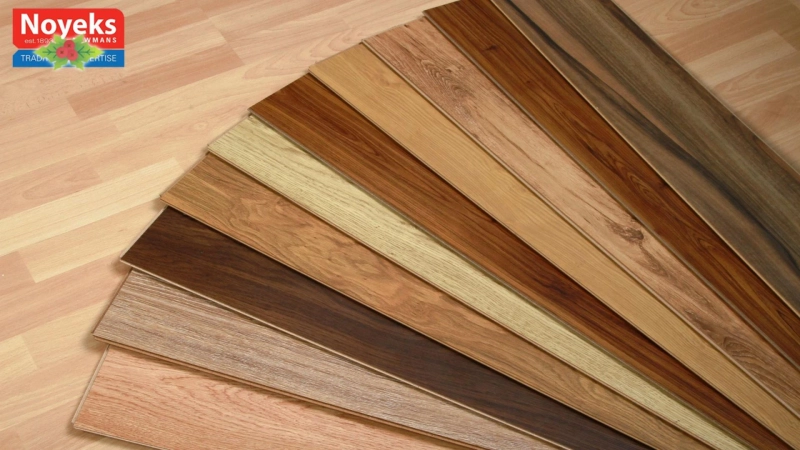There is no need for the extra flooring from your most recent home improvement to end up in a landfill if you have any leftovers. There is no requirement that flooring is utilized only for floors. Many different flooring materials can be used for many additional purposes to improve your home. Here are some more uses for wood floors to give you some ideas if you're unsure where to start.
Alternative Creative Uses for Flooring
1. Design a Statement Wall
An accent wall may dramatically improve any room in your house, whether it's your dining room or your primary living space. Consider transferring your old flooring to one wall as a fun and original focal point rather than throwing it out. You can quickly create a striking wall with a range of flooring materials. Before you start, measure your wall carefully and ensure you have enough extra flooring.
Depending on the available material, you can start attaching the flooring to your wall once you have verified your measurements. You can choose a single, linear motif when designing your statement wall. Consider creating something opulent and distinctive, like a herringbone wood wall, giving any space a striking appearance and lots of drama.
2. Create Shelves from the Remaining Flooring
Strong flooring materials also make great shelves. If you just installed waterproof laminate flooring, you may use this product to create a lovely veneer by glueing it to a piece of solid wood. Making a shelf out of laminate is a terrific method to give your house a unified, coordinated appearance. Apply the laminate straight over a piece of MDF, then mount your newly constructed shelf on the wall.
Cut any remaining tile and apply it to the wood in any desired design if you have some. This simple project is one of the numerous alternative applications for flooring that will give your house a fresh look and more functionality. The shelves make an excellent wall mounted bookshelf that you can hang in your home office or install in your child's room. Have fun with it; the possibilities for bespoke shelves are endless.
3. Organize the Shelves in the Closets or Cupboards
Extra flooring can be a great shelf liner, whether laminate or linoleum. Use this material to assemble shelves for your kitchen, pantry, and bathroom cabinets. It's a great method to line linen cabinets in the bathroom or hallway. You can add linoleum to your cabinets and shelves for simple cleaning and maintenance.
In addition to looking amazing, this material will aid in preventing moisture and spill damage to your cabinets. Stick-on tiles work well as shelf liners as well. Just cut the flooring to fit, then apply it to the surface the same way you would your floors.
4. Utilize Unused Flooring Materials To Resurface A Table
Use your extra flooring to resurface an old table if it needs some TLC. This will give it some new life. Almost any table in your house can get a fresh look thanks to this easy project. It's the ideal approach to updating your furniture and can help you avoid spending money on brand-new items. Take care to thoroughly clean and prepare the surface of your table before applying the flooring material.
When it is time to lay the flooring and the tabletop to improve its adhesion to the table. Before you start, measure the table and make sure you have enough flooring material. Once your project is finished, you can use your repurposed table for dining, crafting, or as a lovely potting table outside in the garden.
Read More - Reasons to Install Wood Flooring On Stairs
5. Renovate a Bar Elegantly
The flooring may be used in various ways, and refinishing your bar is one excellent method to make the most of your surplus materials. If satisfied with your bar top, apply some extra flooring to the bottom borders. Your bar will now have a fresh texture, vibrant color, and an eye-catching design that stands out in any setting.
To provide definition and a two-tone appearance to the base of your bar, apply hardwood, laminate, or vinyl planks. Make sure you have enough flooring available by taking measurements around the bar or its top. To ensure the material is completely secured, use glue or a nail gun to attach it.
6. Make Beautiful Frames Out Of Flooring
Beautiful frames for your favorite pictures may be created using wood and wood-look vinyl, or you can use these materials to create a frame for a mirror. Then, trim each piece to fit the size and proportions of your frame. Use nail glue to join the pieces, and then allow them completely dry before adding glass and your favorite picture.
If the floor is made of solid wood, join the pieces with brad nails or staples. Additionally, you can employ custom frames to enhance the texture and beauty of your artwork. Before you begin the job, paint the flooring if you wish to frame the artwork, photographs, or mirror in a different material or shade.
7. Remaining Flooring in the Garden
It can be a very handy item to highlight your outdoor area, regardless of the type of flooring you have installed. The remaining planks can be used to build a nice garden fence. To enclose flowerbeds, bushes, or garden beds, cut each piece to the desired size and bury it in the ground.
This little task is enjoyable to complete and improves the landscaping's appearance. Small bits of new flooring can be used to make unique garden markers if you have few. Name each piece with the type of flowers, herbs, or vegetables you have by painting or using permanent markers to mark it.
Conclusion -
You can integrate flooring in various inventive ways, from photo frames to accent walls. Enjoy yourself while working on your project, and take pride in the idea that you're recycling and reusing items that could otherwise find their way into a landfill. You can always donate anything to a nearby nonprofit organization if you want to use something other than your wood floors for a DIY project.



